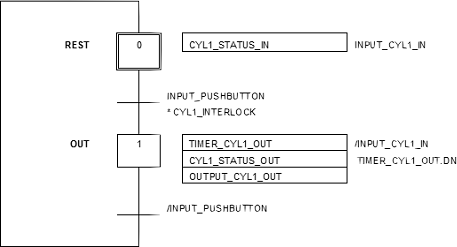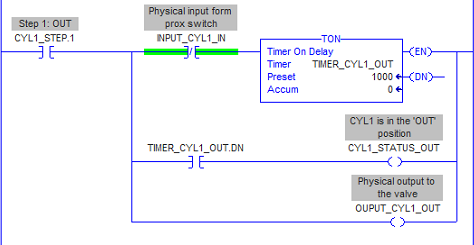by John Schop
I often find that using SFC's or Grafcets is the easiest way to design industrial automation systems. I have worked for several machine builders, and one of them had given the term 'SFC logic' another meaning. There was absolutely no process in their PLC logic that was not documented by an SFC or as I like to call it, a Grafcet. After some getting used to that, I absolutely loved the way it enabled me to program and troubleshoot complex machinery, and ever since, I've tried to use this method whenever I could.
I seriously believe that no machine cannot be programmed with this method, and if I would have the opportunity to make the decision every time (unfortunately the customer is often involved in this), I would never use anything else.
What is even better is that with a little bit of programming skills, it is possible to translate these Grafcets to ladder logic. This means nobody has to buy the expensive SFC programming modules, it is easy to read and troubleshoot, and less skilled maintenance people that you often have to deal with are not completely lost in a pile of spaghetti.
This also means that your Grafcet documentation for a certain machine does not change with the manufacturer of the PLC you are using. The translated logic is the only thing that is slightly different.
Of course, there are numerous ways of programming a Grafcet in ladder logic, but it is good to have a standard way of doing it every time, and I will show you how I do it. This article uses RSLogix 5000, but it is the same concepts in any PLC, with some minor differences.
We are going to look at a little Grafcet first, so we get the idea of what is going on. Let us assume I have a simple cylinder (CYL1) that will have to move out, when a pushbutton is pressed. Once the pushbutton is released, the valve that operates the cylinder returns to its normal state, and the cylinder will move in (the rest position).
Some other assumptions:
- There is only one proximity switch on this cylinder, telling me it is at the rest position, so I'll have to assume it's in the 'out' position if I don't see that input for a while.
- It cannot move out in some interlocking conditions.

This probably requires some explanation, because over the years, I have developed this way of notation, which does not necessarily follow the strict rules of IEC1131 or whatever other standards there may be, but I'm assuming that if you read this, you understand the concept of steps and transitions.
Look at the transition from Step 0 to Step 1, it says, 'INPUT_PUSHBUTTON * CYL1_INTERLOCK' which in my world means: 'the input from the pushbutton needs to be there, AND the interlock needs to be satisfied'. That would be a whole lot to write down in your documentation though, so that is why I do it that way. In case I need an 'OR', I use the '+' sign. The transition from Step1 to Step 0 says, '/INPUT_PUSHBUTTON', which means 'NOT that input'.
On the right side of the steps, you see what is actually going to happen in that step.
Step 0 does nothing except that we will tell the rest of our program that CYL1 is in, with 'CYL1_STATUS_IN', which is a Boolean variable that is true if we are in step 0, and the input from the prox 'INPUT_CYL1_IN' is true. Doing it this way makes sure we only use that input in one spot in our program, so if we ever have to change the physical location of that input, we only have to change our program in that one spot.
In Step 1, we are going to do some more stuff. For example, if 'INPUT_CYL1_IN' is not true, we're starting a timer 'TIMER_CYL1_OUT', and after that timer has expired 'TIMER_CYL1_OUT.DN', we will make 'CYL1_STATUS_OUT' true. In addition, we have to energize the actual output 'OUTPUT_CYL1_OUT'.
Now, to translate all this to ladder logic, we will follow a certain order of things:
- Gather the information for the interlocks
- Program the transitions
- Convert the step to a coil (I'll explain this as we go along)
- Program the outputs, timers and status in that step.
Let's see what it looks like in logic, step by step:
1. Gather information about interlocks:

As you can see, I have fantasized some conditions for this interlock.
2. Let's do the transitions, first Step 0 to Step 1:

I've introduced some variables here, 'CYL1_STEP', which is a DINT that we're going to use the separate bits of to indicate a step, and also 'CYL1_STEPNUMBER', another DINT, to store our step number in.
Step 1 to Step 0:

Now I use bit number 1 from our DINT called 'CYL1_STEP', to indicate that we're in Step 1, and I move a value of '0' into 'CYL1_STEPNUMBER', which will make us go back to Step 0 after the:
3. Conversion to coils.
This conversion to coils makes sure that every step is true for at least one PLC cycle after the transition. I use the value in 'CYL1_STEPNUMBER' to coil a certain bit in 'CYL1_STEP':

A little information on this one: because I latched the bit with an OTL instruction, I clear 'CYL1_STEP' first; to make sure we cannot have two steps at the same time. It is essential that not more than one-step can be active in one PLC cycle, and every step will be active for at least one PLC cycle at a time. You might have to read that last sentence a couple of times before its clear, but that is how it is.
Now we are ready to do something within these steps:
4. Program the outputs, timers and status for a step:
Let's do Step 0:

And then Step 1:

And that's all, really.
Of course, in real life, you'll have to program some more stuff after this, like a diagnostic in Step 1, to indicate that the cylinder did not reach it's 'OUT' position within a certain time, and the same for Step 0 if it does not reach the 'IN' position.
Another thing that might come in handy is a diagnostic to indicate that someone is pressing the pushbutton, but the interlocks are not ready yet, and I am sure you can come up with a lot more stuff like that. I am just trying to give you a basic idea of how to program an SFC real nice and clean in ladder logic, and more important, how to document them.
A typical Grafcet that you would use in a program could of course be exactly like this, but most of the time you are going to need some more complex structures. If people are interested in that, I might elaborate on it later. I could probably write a whole book on it, now I am thinking about it.








0 Comments:
Post a Comment